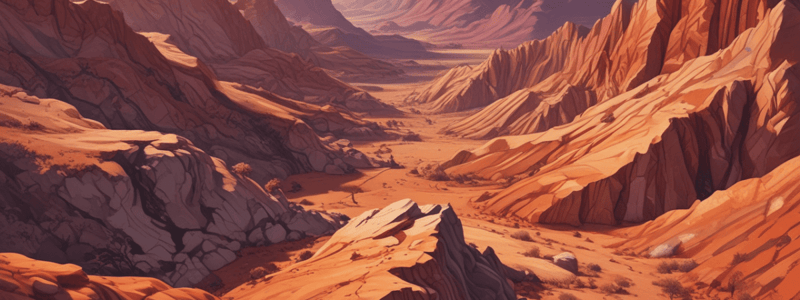Podcast
Questions and Answers
What is the main difference between a raised bog and a blanket bog?
What is the main difference between a raised bog and a blanket bog?
- Water table level (correct)
- Type of vegetation
- Location
- Soil composition
Which of the following rocks is NOT a metamorphic rock?
Which of the following rocks is NOT a metamorphic rock?
- Basalt
- Quartzite
- Granite (correct)
- Shale
What is the main way that parent material influences the type of soil that eventually develops?
What is the main way that parent material influences the type of soil that eventually develops?
- Through the amount of rainfall it receives
- Through its location
- Through the type of vegetation that grows
- Through its mineral composition (correct)
What is the term for the process of rocks being broken down into smaller particles, which contributes to soil formation?
What is the term for the process of rocks being broken down into smaller particles, which contributes to soil formation?
Which of the following is a characteristic of soils developed under coniferous forest, compared to those developed under grassland?
Which of the following is a characteristic of soils developed under coniferous forest, compared to those developed under grassland?
What is the type of sedimentary rock that is prevalent in the Burren, Clare?
What is the type of sedimentary rock that is prevalent in the Burren, Clare?
Flashcards are hidden until you start studying
Study Notes
Bogs and Soil Formation
- A raised bog is a self-sustaining ecosystem with peat accumulation, whereas a blanket bog is a peat-covered landscape with no obvious boundaries.
- Two main factors involved in the formation of metamorphic rocks: high pressure and high temperature.
Metamorphic Rocks
- Two examples of metamorphic rocks:
- Marble (develops from limestone)
- Slate (develops from shale)
Soil Formation
- Parent material influences soil type through its chemical and physical properties, which affect the soil's fertility and structure.
- Limestone and granite have different effects on soil formation: limestone produces alkaline soils, while granite produces acidic soils.
- To identify limestone as a parent material, look for:
- High calcium carbonate content
- Presence of fossilized shells or coral
- Formation of peat bogs in Ireland: cool, wet climate with limited oxygen, resulting in slow decomposition of plant matter.
Rock Types
- Classification of rock types:
- Quartzite: metamorphic rock
- Shale: sedimentary rock
- Basalt: igneous rock
Peat Bogs and Minerals
- Three minerals found in peat bogs in Ireland:
- Calcium
- Magnesium
- Potassium
- Three minerals present in igneous rocks:
- Feldspar
- Quartz
- Mica
Weathering and Soil Formation
- Weathering of rocks contributes to soil formation through physical and chemical breakdown of rocks into smaller particles.
- Most soils in Ireland are regarded as young due to the country's glacial history, which stripped away old soils and left behind fresh rocks for weathering.
Burren, Clare
- The Burren, Clare is characterized by the presence of limestone, a type of sedimentary rock.
- A chemical process that aids in the weathering of limestone is carbonation, where CO2 reacts with water to form carbonic acid, which dissolves the limestone.
- One feature of soil formed from limestone is its high pH level.
Soil Development
- Three differences between soils developed under coniferous forest and grassland:
- Coniferous forest soils tend to be more acidic and have a thicker humus layer
- Grassland soils tend to be more alkaline and have a thinner humus layer
- Coniferous forest soils may have a higher concentration of nutrients
- Three factors that influence soil formation:
- Parent Material: affects soil chemistry and structure
- Topography: affects soil drainage, erosion, and deposition
- Living Organisms: affect soil fertility, structure, and nutrient cycling
Studying That Suits You
Use AI to generate personalized quizzes and flashcards to suit your learning preferences.




